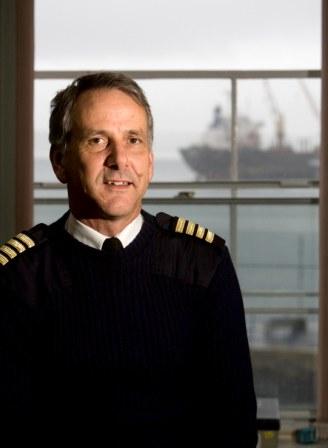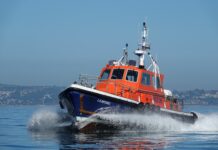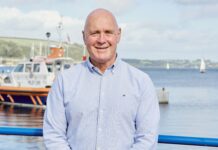As chief executive and harbour master of Falmouth Harbour Commissioners, Captain Mark Sansom has a wide-ranging remit at the statutory port authority.
After a career in the Merchant Navy and Sultan of Oman’s Royal Yacht Squadron, followed by three years as a salvage and
mooring officer for the Ministry of Defence Mark, Sansom moved to Falmouth as deputy harbour master in 1992, and was
promoted to his current position eight years later.
While Falmouth Harbour is home to a diverse group of companies with a combined turnover exceeding £100 million, perhaps his most pressing concern at the moment is ensuring a sustainable future for the harbour, and seeing that it is dredged to allow in the new breed of super liners, and the thousands of extra tourists they would bring into Cornwall. But things are never simple…
Business Cornwall: Let’s start with a little bit about Falmouth Harbour, and how it operates.
Mark Sansom: This is a trust port, a Victorian designed institution where the management of the port was taken out of Government hands and put in the hands of local groups of ‘worthies’ who were allowed to make appointments to the trust board.
And it’s been an enduring structure. What has been really good about it, is it has a much more social mission perhaps than if you were just distributing profits to shareholders. If you contrast it with the mission of a private port, where it is to serve the bottom line as much as it can, the profit distribution is only about making shareholders happy. And the difficulty when you deal with ports is that your business case is largely a geographical monopoly, not necessarily something you’re working for in a truly competitive environment.
BC: Are most ports in the UK private?
MS: There is a really interesting mixture. Most of the larger ports are privately owned but there are some larger trusts still around. The majority of smaller ports will be trust, but there are some council owned models around as well. The whole thing is a real mixture.
I have been here since 1992, during the time when trust ports really fell into disrepute to some extent. Then the freedom of information process started and people began to be much more interested in how these type of undertakings were managed.
A lot of trusts fell short and had become quite complacent about their mission in life. Many of the personalities involved had been serving the trusts for many years and had become a personification of the trust.
So there was a big clear out and in 2000 they introduced a guidance for good governance of trust ports. It encouraged us to move on a lot of our commissioners and recruit on merit, look out for talent on the board, and bring people forward in a much more professional way, while keeping the trust mission and delivering a return to stakeholders, and taking account of the wider process of the port – good value, services, and regard that as a dividend, opposed to a shareholder dividend. And that is largely how the trust part of it has evolved. It has been a fascinating role.
I came here in 1992 as deputy harbour master, very much in the old style of trust port management and had to go through all the changes, and a complete makeover of safety functions which came in after the Sea Empress (oil spill disaster off Welsh coast in 1996).
All of this peaked in 2000, and by coincidence I was appointed Harbour Master on January 1, 2000, so all of these issues landed in my lap. So it’s been great! (laughs).
BC: So what are your responsibilities as Harbour Master?
MS: I have two distinct roles, as harbour master and chief executive. The harbour master element is strictly marine safety functions. We have a large harbour area, stretching something like 16 square miles going up to virtually St Just on the Carrick Roads, and Penryn on the Penryn River, and then south about three miles out to sea. A lot of sea area, but very little land infrastructure.
So my job as harbour master is to manage the safety of navigation, and trying to ‘de-conflict’ the uses of those areas and to make sure as far as possible that we accommodate both commercial shipping – the needs of the ships, the bunker barges and tugs etc, and at the same maintain the basis that the recreational users can go out and use it. And that can be challenging, because a lot of these uses don’t always mix that well. For example, you might have areas favoured by divers but if you have power boats whizzing about the place, there are obvious dangers with that. So it’s about how you manage those types of issues.
BC: And chief executive is more the business side?
MS: Yes. And we do have our own businesses in terms of we have a number of moorings we rent out, a visitor’s yacht haven, a boat park slipway, and we manage those businesses through the leisure services department. And on top of that there are the external relationships, because the trust port is integral in the wider port of Falmouth, including the docks and the other key stakeholders there. It’s about trying to progress how the port is going to grow and the role we have there.
BC: What sort of powers do you have?
MS: We have powers and duties. We have our own statutes and the rights to promote bye laws and regulate the harbour. A&P have their own harbour authority as well, with a small boundary outside their premises. We overlap in certain functions we carry. A lot of their harbour authority type functions we would actually carry out for them under an agency arrangement.
BC: What are the main challenges facing the harbour at the moment?
MS: The main challenge is really the depth of water. The approaches to the docks are shallow.
BC: The dredging issue?
MS: Yes. It’s coming down to the fact that ports have a continuing need to develop, as ship sizes increase. And if you don’t react to that need, you start along this obsolete path.
And you can see examples of that sort of thing in a lot of areas. In Cornwall, the original small ports were built for coastal transport. It was a lot easier to move goods around the coast than it was by land because the roads were so poor. You can see as the ship sizes have grown, a lot of those ports have become obsolete and are not being maintained in any particular way. Even if you look at places like Penzance and the dry dock facility there, the ship size has really increased to the point where their potential market sector has reduced, which has had a really big impact on their potential business. All ports go through this, and you have to react to the changes.
We’re at a point now where we have less than a five metre approach channel, we are too shallow to serve the shipping needs into the future. So we’re fairly clear and the Falmouth Harbour Commissioners are looking to assist in getting the port dredged. We see that as a major issue for the future commercial viability of the port.
BC: Are you leading this campaign?
MS: We have a major role, yes. We’ve had a lot of meetings with local authorities and various agencies to try and persuade them to take this case forward.
BC: Last year the RDA said they could not afford to support the project. How is the quest for securing funding from elsewhere coming along?
MS: There are two strands to the project. The first is that we are looking to dig a channel in an area of special conservation, so there are a number of environmental challenges, and the second is funding.
Whereas a few years ago requirements were not that great, because it was accepted that you would dredge it, dump it and dispose of it. But now there is a much bigger process.
BC: You’re talking about the infamous calcified seaweed?
MS: Those sort of issues. And it has made the process vastly more expensive as well. In terms of trying to get some sort of commercial return, at one stage that would have been realistic.
BC: Before it would have cost hundreds of thousands to dredge, but now millions. Is that right?
MS: It would be a multi-million pound project now, yes. In the order of about £20 million, because of the treatments of contaminants and the environmental issues that arise from it. So that no longer has commercial viability in its own right, because no matter how well your business does afterwards, it’s going to struggle to pay off that short-term investment.
So if this is to go forward, it has to be on the basis that this is a strategic investment. And that has got to be public funded to some degree. That sort of changes the role of the port into the strategic port for Cornwall, rather than just looking at it as a micro port investment which has been the traditional way we have planned investments.
BC: Do you sometimes get frustrated by all the extra regulations and hoops you have to jump through?
MS: (laughs) I have sort of come to terms with it. I have been doing this job for ten years now.
BC: What’s so bad about calcified seaweed? Where’s the issue with environmentalists?
MS: Calcified seaweed is a habitat for certain species of marine life. The advice we’ve had is yes, it will cause a disturbance, but the habitat will recover and the compensation built into the scheme will actually increase the area of calcified seaweed.
Also it affects a relatively small area of the entire amount of calcified seaweed within the conservation area. So we believe those effects should be tolerable. But from the environmental point, Natural England who have the stewardship of that area, are rather more pessimistic about the
recovery rates and impact dredging will have. And this is where it becomes really challenging. The habitat’s regulations aren’t really designed to balance out those two arguments. So it’s taking a lot of work and money to work through these.
BC: Consultants must be having a field day!
MS: I think it’s fair to say environmental consultants have been doing quite well since the environmental regulations were introduced. With the habitat’s regulations, it is an area in particular where there are an amount of studies needed. Previously, you could assume that if there wasn’t a reason to believe you were going to have an [adverse] effect, you could assume you weren’t. But now the process has been reversed. Unless you can absolutely prove you are not going to have an effect, it is assumed that you are.
BC: And where are we now in the process?
MS: We have consent applications in and have had a number of meetings. We are quite well advanced in getting these consents issued, but there are a number of obstacles still to overcome, calcified seaweed probably being the biggest sticking point in the whole process.
BC: What sort of timescale are we looking at?
MS: It’s difficult to say. Where a case is difficult or contentious, the consented process expands out into an indefinite timescale. But we are a looking at determination within months.
BC: And then there’s the financing side. How’s that progressing?
MS: We’ve had a lot of help from Cornwall Council. There is a view that this is a strategic project for Cornwall. There is a master plan going on, looking at all the port’s activities now and what the future activities could be, and the economic value that will have. So we’ll end up with the definitive argument to what extent this project would be worthwhile, when any public investment is sought. And then there is the process of finding suitable public funding to put into place.
BC: Ultimately, is it all about being able to allow the new breed of super liners in to dock at Falmouth?
MS: There are numerous reasons why we would like to dredge, but the cruise ships is the obvious quick win. If you look at what has happened in the last four or five years, and amount of ships willing to stop and tender their passengers in, has reduced quite drastically. As the ships get bigger, if you’re tendering in three or four thousand passengers at a go, that’s a massive logistical exercise both at the ship’s end and the shore end. And you’ve always that got that possibility that the weather could deteriorate and you’ve still got a couple of thousand people ashore.
And passengers will always give negative feedback if they have been stood around in the rain, waiting for tenders. The upper limits of tendering size are coming in with the new vessels. We’re getting a very large expansion in cruise ship size, and that’s really putting an end to that part of the
market, and the tendering of passengers. So even though Falmouth always scores well in passenger feedback from the visits, we are going to be faced with a declining number of vessels and passengers unless we do something about it.









